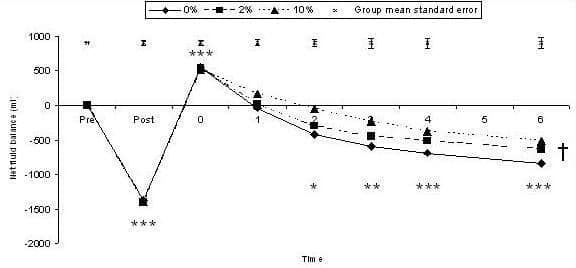Hypotonic carbohydrate-electrolyte solutions are more effective for rapid rehydration than water (Gonzalez-Alonso et al. 1992) due to active co-transport of solutes leading to an increased net efflux of water from the intestinal lumen (Schedl & Clifton, 1963). Hypertonic solutions are thought to be ineffective rehydration solutions due to the net movement of water into the small intestine (Leiper & Maughan, 1986) from the extracellular fluid (Evans et al. 2005) that follows their ingestion. However, the reduction in plasma volume that occurs following ingestion of a hypertonic solution may lead to reduced urinary water loss due to an increase in the concentration of vasopressin and aldosterone, thus aiding the rehydration process. Six healthy male volunteers were dehydrated by 1.9 ± 0.1% body mass by intermittent cycle ergometer exercise in a warm, humid environment. Beginning 30 min after the end of exercise, subjects drank, over a period of 1h, a volume that amounted to 150 (130-150)% (median (range)) of the body mass loss. Drinks contained either 0, 2 or 10% glucose with 25 mmol/l NaCl, distilled water and lemon flavouring and had osmolalities of 79 ± 4, 193 ± 5 and 667 ± 12 mosm/kg, respectively. Blood and urine samples were collected prior to and 30 min after exercise and at 0, 1, 2, 3, 4 and 6 h following the rehydration period. Statistical analysis included repeated measures ANOVA and Tukey or Dunnett’s pairwise comparisons. Cumulative urine volume was greater on the 0% trial than on the 10% trial (P < 0.001). Net fluid balance during the 10% trial was greater than during the 0% trial (P = 0.002) and subjects remained euhydrated for 1 h longer on the 10% trial than on the 2% trial (Fig. 1). Plasma volume was elevated from pre-exercise levels immediately after and 1 h after rehydration during the 2% trial (P < 0.05). These results suggest that high-carbohydrate drinks can be effective rehydration solutions. As plasma volume was elevated from pre-exercise levels after rehydration on the 2% glucose trial but not on the 10% trial it would seem that the beneficial effect of hypertonic, energy-dense solutions on net fluid balance may be due to the avoidance of a large acute increase in plasma volume and consequent reduction in plasma water retention hormones that occur following ingestion of a hypotonic solution.
University College London 2006 (2006) Proc Physiol Soc 3, PC126
Poster Communications: Post-exercise rehydration in man: role of drink osmolality
Gethin Hywel Evans1, Susan M Shirreffs1, Ronald J Maughan1
1. School of Sport and Exercise Sciences, Loughborough University, Loughborough, United Kingdom.
View other abstracts by:
Figure 1. Net fluid balance during all trials. † Net fluid balance loss during 0% glucose trial compared to 10% glucose trial (P = 0.002). * 0% time point different than pre-exercise value (P < 0.05). ** 0 and 2% time point different than pre-exercise value (P < 0.05). *** 0 2 and 10% time points different than pre-exercise value (P < 0.05).
Where applicable, experiments conform with Society ethical requirements.

